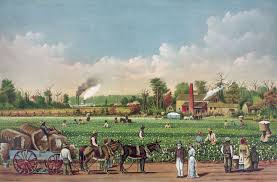Stamp: Coffee Picking (Zambia 1988)
Coffee Picking (Zambia 1988)
20 May (Zambia ) within release International Fund for Agricultural Development goes into circulation Stamp Coffee Picking face value 10 Zambian kwacha
| Stamp Coffee Picking in catalogues | |
|---|---|
| Michel: | Mi: ZM 447 |
Stamp is square format.
coffee pickingAlso in the issue International Fund for Agricultural Development:
- Stamp - Farmer and cattle face value 2.85;
- Stamp - Coffee Picking face value 10;
- Stamp - Cassava crop face value 50;
- Stamp - Net fishing face value 2.50;
|
Data entry completed
53%
|
|
|---|---|
| Stamp Coffee Picking in digits | |
| Country: | Zambia |
| Date: | 1988-05-20 |
| Perforation: | 14 x 14¼ |
| Emission: | Commemorative |
| Format: | Stamp |
| Face Value: | 10 Zambian kwacha |
Stamp Coffee Picking it reflects the thematic directions:
Agriculture is the cultivation and breeding of animals, plants and fungi for food, fiber, biofuel, medicinal plants and other products used to sustain and enhance human life.[1] Agriculture was the key development in the rise of sedentary human civilization, whereby farming of domesticated species created food surpluses that nurtured the development of civilization. The study of agriculture is known as agricultural science. The history of agriculture dates back thousands of years, and its development has been driven and defined by greatly different climates, cultures, and technologies. Industrial agriculture based on large-scale monoculture farming has become the dominant agricultural methodology.
Development aid is a type of foreign/international/overseas aid given by governments and other agencies to support the economic, environmental, social, and political development of developing countries. Closely related concepts include: developmental aid, development assistance, official development assistance, development policy, development cooperation and technical assistance. It is distinguished from humanitarian aid by aiming at a sustained improvement in the conditions in a developing country, rather than short-term relief. Development aid is thus widely seen as a major way to meet Sustainable Development Goal 1 (end poverty in all its forms everywhere) for the developing nations.
Plantations are farms specializing in cash crops, usually mainly planting a single crop, with perhaps ancillary areas for vegetables for eating and so on. Plantations, centered on a plantation house, grow crops including cotton, cannabis, coffee, tea, cocoa, sugar cane, opium, sisal, oil seeds, oil palms, fruits, rubber trees and forest trees. Protectionist policies and natural comparative advantage have sometimes contributed to determining where plantations are located.



